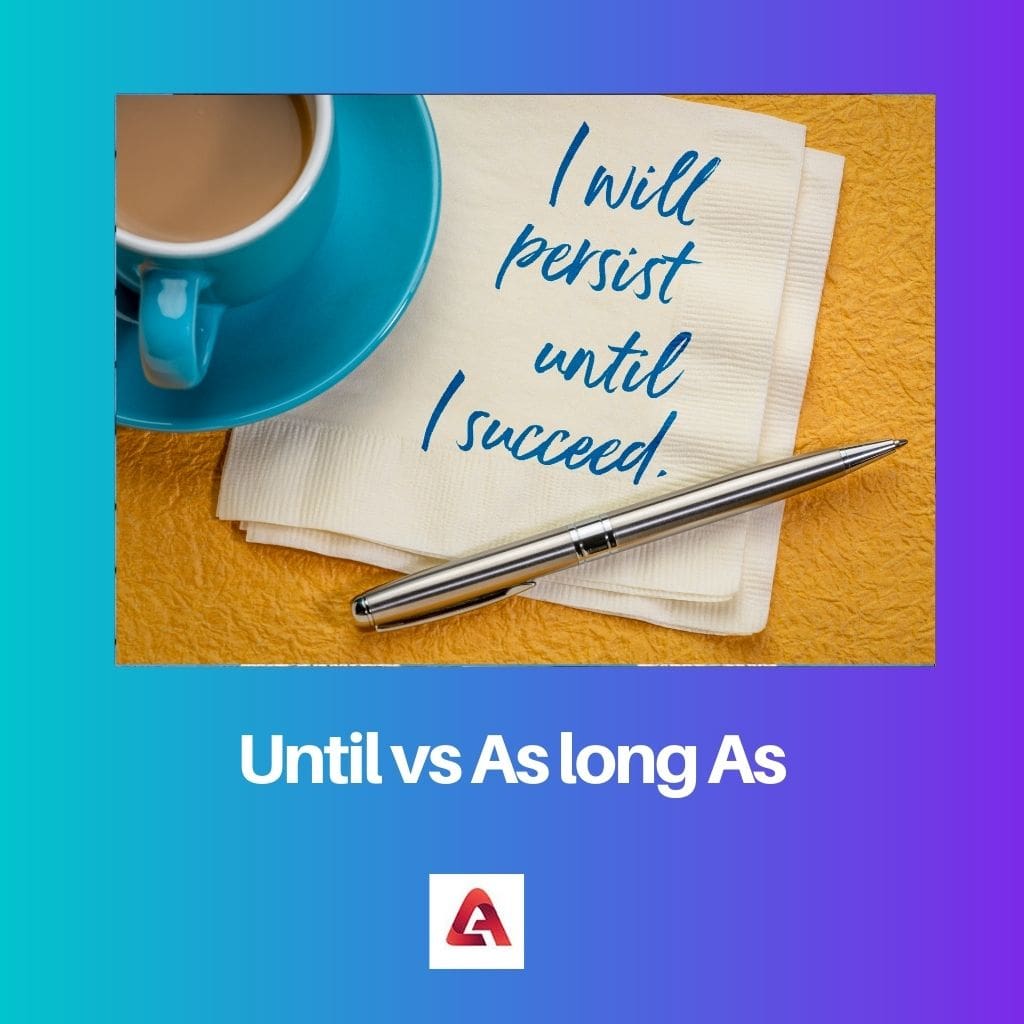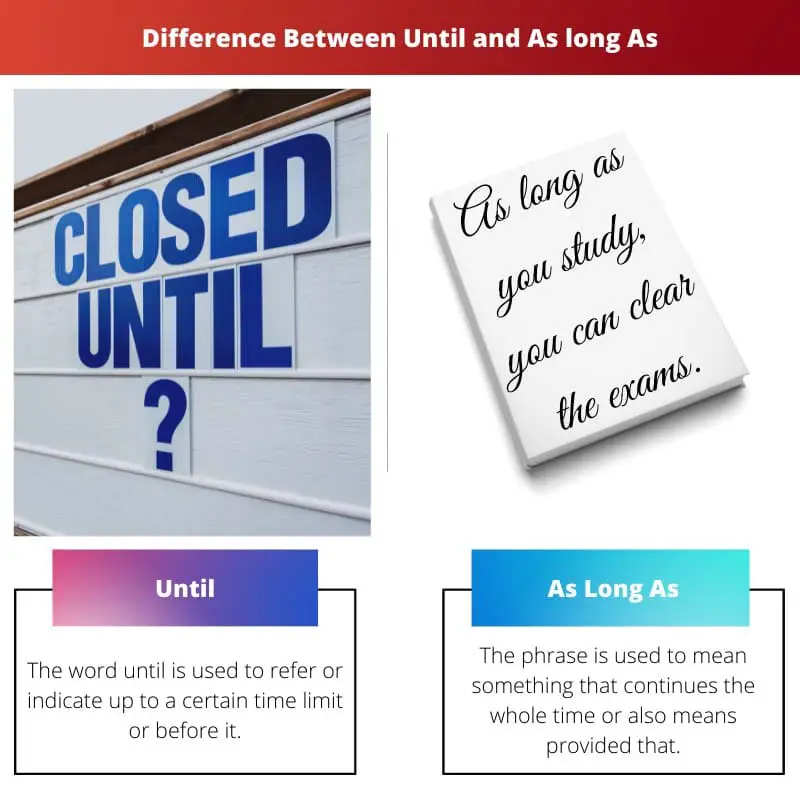“Until” indicates a specific endpoint or moment in time, implying a cessation or completion of an action or state. It denotes a finite duration or condition, emphasizing the eventuality of change or conclusion. On the other hand, “As long as” implies a continuous duration or condition, suggesting persistence or continuity without a defined endpoint.
Key Takeaways
- “Until” indicates the end of a specific time frame or condition; “as long as” implies a continuing state or action under certain conditions.
- “Until” is used when a change is expected after a specified point, whereas “as long as” suggests that the status quo will be maintained given certain circumstances.
- Example: “Wait here until I return” (action ends when the speaker returns); “You can stay as long as you want” (action continues based on the listener’s desire).
Until vs As Long As
Until can be used as a conjunction and preposition as it gives the meaning of the end of some action. For example, “The project can’t proceed further until you identify the errors.” As long as can be used as a conjunction and idiom. It shows the continuity of the action that is still happening.

While ‘until’ is a word, ‘as long as’ is a phrase. The term ‘until’ denotes or refers to a particular time, while the word ‘as long as’ refers to a specific duration of time.
The word ‘until’ speaks of a future event or condition, while ‘as long as’ talks more of a present action or state. While ‘until’ indicates any time in the future, ‘as long as’ has some conditional element.
Comparison Table
Until vs. As Long As
| Feature | Until | As Long As |
|---|---|---|
| Function | Conjunction mostly used in subordinate clauses | Conjunction mostly used in subordinate clauses |
| Meaning | Expresses a time limit | Expresses a condition based on time |
| Timing | Action in the main clause happens after the event in the subordinate clause | Action in the main clause is ongoing or repeated as long as the condition in the subordinate clause is true |
| Examples | * “Wait until the sun sets.” (Wait until a specific time.) * “I won’t leave until you finish your homework.” (I won’t leave after you finish your homework.) | * “You can play as long as you finish your chores first.” (You can play on the condition that you finish your chores first.) * “We’ll walk as long as the weather is good.” (We’ll walk for as long as the weather remains good.) |
| Formality | Both formal and informal | Both formal and informal |
When to Use the Word Until?
Definition and Usage of “Until”
“Until” is a preposition and conjunction used to denote a point in time before which an action or state continues. It indicates a temporal endpoint or limit, after which a change, cessation, or transition occurs. Understanding when to use “until” is essential for precise communication in both spoken and written English.
Temporal Endpoint
“Until” primarily functions to establish a temporal boundary, indicating the duration of an action or state until a specific point in time is reached. For example:
- “She waited until midnight for the train to arrive.”
- “The store will remain open until 9 p.m.”
In both instances, “until” clarifies the timeframe during which the action (waiting, keeping the store open) persists, specifying its endpoint (midnight, 9 p.m.).
Conditional Limitation
Additionally, “until” can convey conditional limitation, suggesting that an action or state will continue until certain conditions are met or a particular event occurs. For instance:
- “He will not stop studying until he understands the concept completely.”
- “The meeting will proceed until a consensus is reached.”
Here, “until” emphasizes the conditionality of the action, signifying its continuity until the specified conditions are fulfilled.
Contrast with “Up to”
It’s important to note that “until” and “up to” are sometimes used interchangeably, but they convey slightly different nuances. While “until” emphasizes the temporal endpoint, “up to” emphasizes inclusivity, indicating the maximum extent or limit without necessarily implying a change or transition. For example:
- “She can work until 5 p.m.” (implies cessation at 5 p.m.)
- “She can work up to 5 p.m.” (implies working until 5 p.m. but doesn’t necessarily imply cessation at that exact time)

When to Use the Phrase As long As?
Understanding the Usage of “As long as”
The phrase “as long as” is commonly used in English to establish conditions or requirements that must be met for a particular action, state, or situation to continue. It implies a conditionality that determines the duration or sustainability of something. A clear understanding of when to use “as long as” is crucial for effective communication.
Conditional Requirement
“At long as” introduces a condition or set of conditions that must be satisfied for the specified action or state to persist. It denotes a continuous duration contingent upon the fulfillment of certain criteria. For example:
- “You can borrow my car as long as you return it by 6 p.m.”
- “The party will continue as long as the weather remains favorable.”
In these sentences, “as long as” emphasizes the requirement that must be met (returning the car by 6 p.m., favorable weather) for the action (borrowing the car, continuing the party) to continue.
Duration with Condition
Furthermore, “as long as” can indicate a duration or period during which a particular condition holds true, suggesting the temporal extent of the specified situation or circumstance. For instance:
- “She’ll stay in the job as long as she feels challenged.”
- “He’ll support the project as long as it aligns with the company’s goals.”
Here, “as long as” underscores the duration for which the condition (feeling challenged, alignment with company goals) will determine the continuity of the action (staying in the job, supporting the project).
Contrast with “If”
It’s important to differentiate between “as long as” and “if” in their usage. While both introduce conditions, “if” implies a conditional statement that may or may not lead to a specific outcome, whereas “as long as” emphasizes the continuous fulfillment of conditions for the duration specified. For example:
- “You can join us if you finish your work.” (conditional statement)
- “You can join us as long as you finish your work.” (emphasizing continuous conditionality)
Main Differences Between Until and As Long As
- Temporal Endpoint vs. Conditional Continuation:
- “Until” indicates a specific endpoint or moment in time, implying a cessation or completion of an action or state.
- “As long as” establishes conditions or requirements that must be continuously met for the action or state to continue.
- Finite Duration vs. Continuous Conditionality:
- “Until” denotes a finite duration, emphasizing the eventual change or conclusion of the action or state.
- “As long as” implies continuous duration, suggesting persistence or continuity as long as specific conditions are fulfilled.
- Emphasis on Time vs. Emphasis on Condition:
- “Until” emphasizes the temporal aspect, highlighting the timeframe during which the action or state persists.
- “As long as” emphasizes the conditional aspect, emphasizing the requirement that must be met for the action or state to continue.


The details about the usage of ‘until’ and ‘as long as’ were explained very effectively.
It’s always good to brush up on these details once in a while.
I found it very clear.
This article is absolutely brilliant.
I don’t believe this article actually contributes anything new.
I think the post had some valuable insights.
I disagree.
What a helpful information, I wasn’t aware of the difference between ‘until’ and ‘as long as’ before reading this!
Exactly, it was very informative.
I had never come across such a comprehensive comparison on ‘until’ and ‘as long as’ before.
It was a great educational article.
The example sentences were very helpful in understanding the difference.
I learned a lot from this.
This post provides a great explanation about a common confusion amongst many people.
Yes, everyone should read this.
I already knew all of this, nothing new.
This was an enlightening read, it helps to clear up the confusion between ‘until’ and ‘as long as’.
Agreed, it was very helpful.
It’s great to have this explained in such a clear way.
I think the comparison table was quite useful.
Absolutely.
It summarized the key differences perfectly.